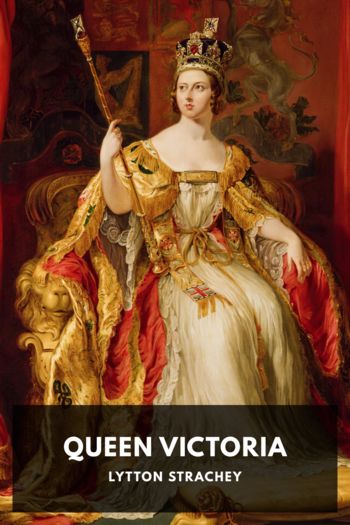Queen Victoria, Lytton Strachey [best books for 8th graders .TXT] 📗

- Author: Lytton Strachey
Book online «Queen Victoria, Lytton Strachey [best books for 8th graders .TXT] 📗». Author Lytton Strachey
The busy years hastened away; the traces of Time’s unimaginable touch grew manifest; and old age, approaching, laid a gentle hold upon Victoria. The grey hair whitened; the mature features mellowed; the short firm figure amplified and moved more slowly, supported by a stick. And, simultaneously, in the whole tenor of the Queen’s existence an extraordinary transformation came to pass. The nation’s attitude towards her, critical and even hostile as it had been for so many years, altogether changed; while there was a corresponding alteration in the temper of—Victoria’s own mind.
Many causes led to this result. Among them were the repeated strokes of personal misfortune which befell the Queen during a cruelly short space of years. In 1878 the Princess Alice, who had married in 1862 the Prince Louis of Hesse-Darmstadt, died in tragic circumstances. In the following year the Prince Imperial, the only son of the Empress Eugenie, to whom Victoria, since the catastrophe of 1870, had become devotedly attached, was killed in the Zulu War. Two years later, in 1881, the Queen lost Lord Beaconsfield, and, in 1883, John Brown. In 1884 the Prince Leopold, Duke of Albany, who had been an invalid from birth, died prematurely, shortly after his marriage. Victoria’s cup of sorrows was indeed overflowing; and the public, as it watched the widowed mother weeping for her children and her friends, displayed a constantly increasing sympathy.
An event which occurred in 1882 revealed and accentuated the feelings of the nation. As the Queen, at Windsor, was walking from the train to her carriage, a youth named Roderick Maclean fired a pistol at her from a distance of a few yards. An Eton boy struck up Maclean’s arm with an umbrella before the pistol went off; no damage was done, and the culprit was at once arrested. This was the last of a series of seven attempts upon the Queen—attempts which, taking place at sporadic intervals over a period of forty years, resembled one another in a curious manner. All, with a single exception, were perpetrated by adolescents, whose motives were apparently not murderous, since, save in the case of Maclean, none of their pistols was loaded. These unhappy youths, who, after buying their cheap weapons, stuffed them with gunpowder and paper, and then went off, with the certainty of immediate detection, to click them in the face of royalty, present a strange problem to the psychologist. But, though in each case their actions and their purposes seemed to be so similar, their fates were remarkably varied. The first of them, Edward Oxford, who fired at Victoria within a few months of her marriage, was tried for high treason, declared to be insane, and sent to an asylum for life. It appears, however, that this sentence did not commend itself to Albert, for when, two years later, John Francis committed the same offence, and was tried upon the same charge, the Prince propounced that there was no insanity in the matter. “The wretched creature,” he told his father, was “not out of his mind, but a thorough scamp.” “I hope,” he added, “his trial will be conducted with the greatest strictness.” Apparently it was; at any rate, the jury shared the view of the Prince, the plea of insanity was, set aside, and Francis was found guilty of high treason and condemned to death; but, as there was no proof of an intent to kill or even to wound, this sentence, after a lengthened deliberation between the Home Secretary and the Judges, was commuted for one of transportation for life. As the law stood, these assaults, futile as they were, could only be treated as high treason; the discrepancy between the actual deed and the tremendous penalties involved was obviously grotesque; and it was, besides, clear that a jury, knowing that a verdict of guilty implied a sentence of death, would tend to the alternative course, and find the prisoner not guilty but insane—a conclusion which, on the face of it, would have appeared to be the more reasonable. In 1842, therefore, an Act was passed making any attempt to hurt the Queen a misdemeanor, punishable by transportation for seven years, or imprisonment, with or without hard labour, for a term not exceeding three years—the misdemeanant, at the discretion of the Court, “to be publicly or privately whipped, as often, and in such manner and form, as the Court shall direct, not exceeding thrice.”386 The four subsequent attempts were all dealt with under this new law; William Bean, in 1842, was sentenced to eighteen months’ imprisonment; William Hamilton, in 1849, was transported for seven years; and, in 1850, the same sentence was passed upon Lieutenant Robert Pate, who struck the Queen on the head with his cane in Piccadilly. Pate, alone among these delinquents, was of mature years; he had held a commission in the Army, dressed himself as a dandy, and was, the Prince declared, “manifestly deranged.”387 In 1872 Arthur O’Connor, a youth of seventeen, fired an unloaded pistol at the Queen outside Buckingham Palace; he was immediately seized by John Brown, and sentenced to one year’s imprisonment and twenty strokes of the birch rod. It was for his bravery upon this occasion that Brown was presented with one of his gold medals. In all these cases the jury had refused to allow the plea of insanity; but Roderick Maclean’s attempt in 1882 had a different issue. On this occasion the pistol was found to have been loaded, and the public indignation, emphasised as it was by Victoria’s growing popularity, was particularly great. Either for this or for some other reason the procedure of the last forty years was abandoned, and Maclean was tried for high treason. The result was





Comments (0)